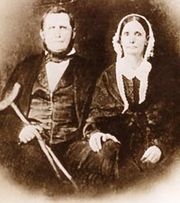
John Crenshaw
Encyclopedia

Salt
In chemistry, salts are ionic compounds that result from the neutralization reaction of an acid and a base. They are composed of cations and anions so that the product is electrically neutral...
, and slave trader, based out of Gallatin County, Illinois
Gallatin County, Illinois
Gallatin County is a county located in the U.S. state of Illinois. According to the 2010 census, it has a population of 5,589, which is a decrease of 13.3% from 6,445 in 2000...
. Although Illinois
Illinois
Illinois is the fifth-most populous state of the United States of America, and is often noted for being a microcosm of the entire country. With Chicago in the northeast, small industrial cities and great agricultural productivity in central and northern Illinois, and natural resources like coal,...
was a free state, Crenshaw leased the salt works in nearby Equality
Equality, Illinois
Equality is a village in Gallatin County, Illinois, United States. The population was 721 at the 2000 census. Near the village are two points of interest, the Crenshaw House and the Garden of the Gods Wilderness.-History:...
from the government, which permitted the use of slaves for the arduous labor of hauling and boiling brackish water to produce salt. Crenshaw was widely believed to be involved in the kidnapping and sale of free black citizens in free states as slaves in the south, an enormously profitable trade later known as the Reverse Underground Railroad
Reverse Underground Railroad
The Reverse Underground Railroad is the term used for the historical practice of kidnapping free Black Americans from free states and transporting them into the American South for sale as slaves...
.
Due to Crenshaw's keeping and breeding of slaves and kidnapping of free blacks, who were then pressed into slavery, his house became popularly known as The Old Slave House and is alleged to be haunted. A grand jury indicted Crenshaw for kidnapping, once in the mid 1820s (the outcome unknown) and again in 1842 when a trial jury acquitted him. The case’s victims, Maria Adams and her seven or eight children, ended up as slaves in Texas. In 1828, Crenshaw took Frank Granger and 15 others downriver to Tipton Co., Tennessee, and sold them as slaves. Crenshaw also kidnapped Lucinda and her children in 1828. She ended up in Barren County, Kentucky. Contemporary letters identifying Crenshaw’s role back both cases. Crenshaw also kidnapped Peter White and three others in the 1840s. They were sold into slavery in Arkansas, but later rescued. Stories of strange noises upstairs coming from victims, date to 1851. Despite accounts that the rooms were slave quarters, Crenshaw family stories indicate a distinction between the plantation’s household servants and field hands, and the victim’s of Crenshaw’s criminal activities. However, problems arose in the indicting of Crenshaw because the Fugitive Slave Act of 1850 required all northern citizens to return runaway slaves to their owners and the Dred Scott decision
Dred Scott v. Sandford
Dred Scott v. Sandford, , also known as the Dred Scott Decision, was a ruling by the U.S. Supreme Court that people of African descent brought into the United States and held as slaves were not protected by the Constitution and could never be U.S...
which stated that all blacks were property whether they were in a free or slave state.
In 2004, the National Park Service named the Crenshaw Mansion, referred to as "The Old Slave House", as part of the Underground Railroad National Network to Freedom program to acknowledge its importance in the reverse underground railroad and the role John Crenshaw played in condemning free blacks to slavery.
External links
- A timeline of the Crenshaw House (pdf)
- Black Kidnappings in the Wabash and Ohio Valleys of Illinois by Jon Musgrave
This article includes public domain text from the National Park Service website

